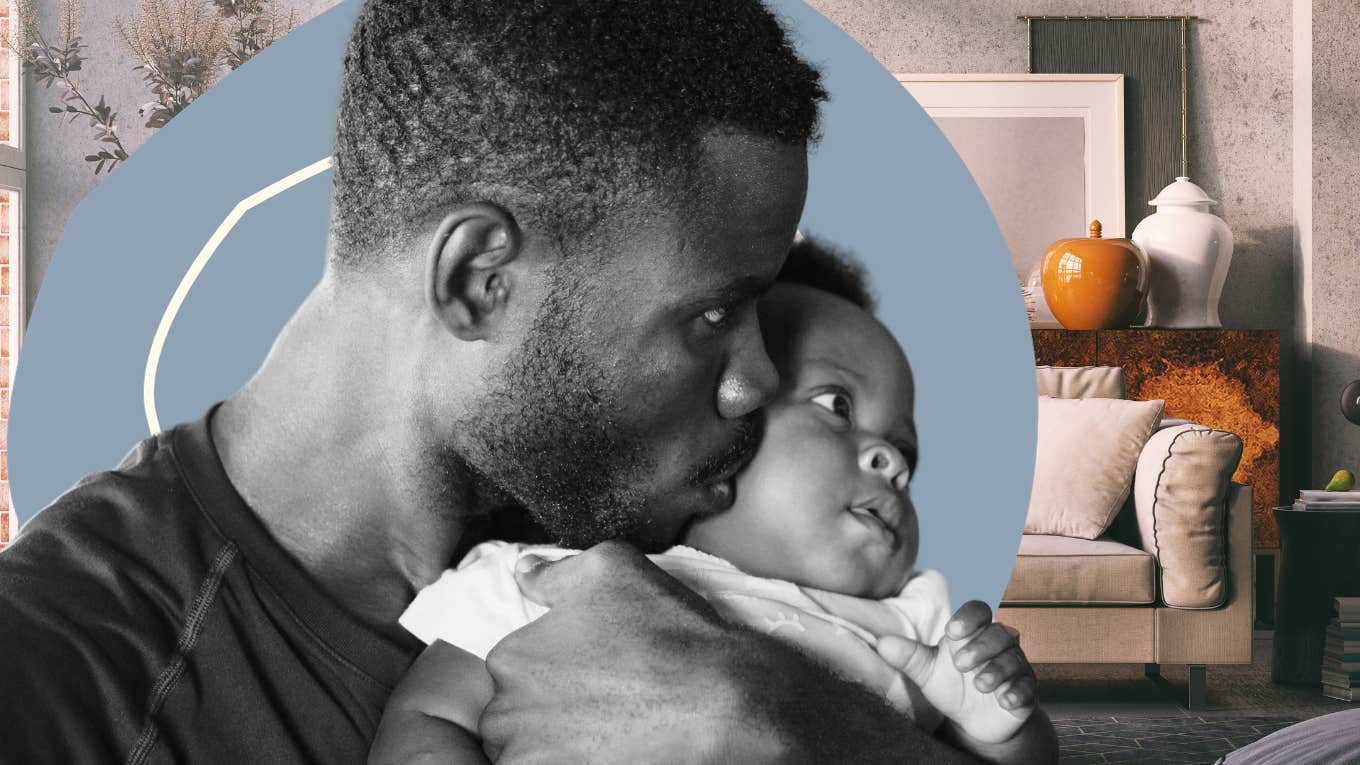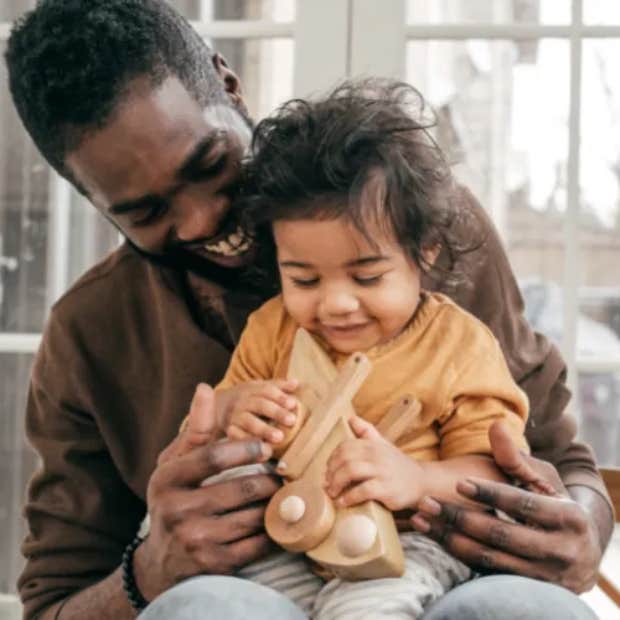The Unsettling Realization My Partner Learned As A Stay-At-Home Dad
Namely, that we don’t value caregivers — and we should.
 TopSphere Media | Unsplash
TopSphere Media | Unsplash When my partner called me at work, his breath sounded labored. “Is everything okay?” I asked with alarm. Everything wasn’t okay. My partner was walking home with our 14-month-old baby on his back, wearing a tank top through which he was copiously sweating.
Were it summer, there would be no cause for concern. No one walks outside for any length of time during a Washington, D.C. summer without copiously sweating — especially if you have a baby on your back.
But it wasn’t summer. It was January, and the temperature outside was a brisk 31 degrees.
I think I’m having a panic attack, he said.
The thought of my husband having a panic attack — with our daughter on his back, blocks away from home — was enough to send my nervous system into overdrive.
I managed to talk him down, but it wasn’t the last time his anxiety would rear its ugly head. He wasn’t a stranger to anxiety — or even to panic attacks, for that matter — but this felt different. His anxiety built on itself that much more quickly when he was simultaneously being entrusted with a human life. Not only that, it was the life of a human who had recently learned how to not just walk but run (sprint, really) — a human who was determined to put her new skill to use whenever he set her down.
My partner wasn’t new to parenting. He’d already been through all this with his 13-year-old son. He worked night shifts for much of his son’s early childhood and was often on childcare duty during the day. But with a girlfriend who stayed home for the first year and an abundance of help from her parents, the work wasn’t quite so… intensive. He still engaged with other adults regularly, still maintained his sense of self, and felt like his contributions were, more or less, seen and understood.
But not so much this second time around.
The 16 months during which my partner served as our daughter’s primary caretaker were eye-opening, to say the least.

Photo: kate_sept2004/Canva
Society has long been dismissive of the work that stay-at-home mothers do, reluctant to even label it as “work.”
As a case in point, my partner and I once attempted to watch a Bill Burr stand-up special in which he took issue with Oprah calling motherhood “the hardest job in the world.” Burr proceeded to compare motherhood to “manly,” physically demanding jobs like trucking, lobster fishing, and roofing. Would you rather do those jobs, he asks, or “hang in the sunshine with a couple of rugrats… send them to bed any time you want on some trumped-up charges because you want to have a drink and watch The Price is Right?… Dude, any job you can do in your pajamas is not difficult.”
My partner said: “This guy has no idea what the heck he’s talking about.”
The difficulty of a job, of course, depends on your metrics. Does “hard” mean physically demanding? Potentially life-threatening? Does it mean that a great deal of money is at stake? That the work must be done out in the “real world?” Are “hard jobs” and pajamas mutually exclusive?
My partner has done a lot of jobs that I bet Bill Burr would consider “hard.” He’s dug ditches, worked night shifts at microchip factories, and treated gunshot victims — just to name a few.
Each of his jobs has demanded different things from him — sweating through hours of physical labor, handling lethal chemicals in a hazmat suit, keeping victims alive in the backs of moving ambulances. Now, he draws from his years of doctorate education and an immense body of knowledge to heal people’s hands.
I’ll concede to Bill Burr that caregiving might not be the hardest job in the world. But my partner, even with his vast and varied experience, would include it in his list of “hardest jobs.”
Bill Burr ends his segment by saying he’s just “messing” with us, but his comments accurately reflect how we tend to view the very real work of caregiving — “playing,” “entertaining,” and “sitting around.” It’s not considered a skilled job, nor a demanding job, nor a job that should merit much, if any, pay. Even though unpaid stay-at-home parents and underpaid care providers enable most other work to get done, we continue to trivialize the complexity and significance of the job.
Why? Well, that one’s easy — because it’s work that has historically been done by women.
Whenever my partner reflects on his stint as a stay-at-home dad, now a decade behind him, he talks first and foremost about how isolated and undervalued he felt.
When he says this, my instinctive reaction is defensiveness because I didn’t feel like I was undervaluing him at the time.
It’s not like I walked into the house after 8.5 hours of work and a 45-minute commute each way expecting dinner on the table and the day’s laundry ironed and folded. I didn’t let him take my coat, then sit down in the easy chair and ask for a whiskey on the rocks.
I’d be hard-pressed to find any working mothers who enjoy these privileges. If the lives of working dads in the 1950s and 60s bore any resemblance to what we see in old movies and TV shows, they had it made.
My partner was great (still is great) about keeping the house clean. He was great at keeping our daughter fed, changing her diapers, taking her on excursions, and foiling her many schemes to make her Great Escape. But when I walked in the door at 6 p.m., dinner, dishes, bathtime, and laundry were a group effort. And until my daughter was 14 months old, I knew my sleep would be interrupted at least once, if not multiple times, throughout the night.
That’s all to say, we were both exhausted and focused on getting through each day. Gratitude was a scarce commodity.
For my partner, it came down to feeling not quite seen. Not just by me, but by society at large. It’s a feeling I would come to know all too well when we had our second child and my partner eventually went back to school. I became the primary caregiver, in addition to the primary income earner.
At work, my “other” role as caregiver undermined my role as a worker — clearly, I was not as committed as my counterparts who didn’t have hard stops at the end of the day. At home, the work of caregiving felt largely taken for granted.
Our roles had partially reversed, and both of us had an opportunity to understand the very real ways in which society renders caregivers invisible.
Caregiving used to be performed in the context of community. It is meant to be performed in the context of community. But as our communities have largely unraveled, as families have become walled off in their own separate homes, care work has become more isolating and emotionally exhausting, demanding an almost total loss of self and continually presenting new challenges for which you’ve never been trained.
RELATED: Being A Stay-At-Home Dad Put A Serious Strain On My Marriage
Caregiving also has the potential to be vastly fulfilling, but it’s hard to find fulfillment in work that the patriarchy consistently trivializes, devalues, and even ridicules. It’s hard when your work isn’t even considered “work” because it’s not paid — and because, yes, you can do portions of it in your pajamas.
Even paid caregivers, who never work in their pajamas, are not paid much. According to Zippia, care providers in the United States make $29,652 per year on average, below what is considered a livable wage in nearly every state.
And yes, even in 2023, whether it’s paid or unpaid, caregiving is still very much considered “women’s work.” Even in households where both spouses work outside the home, mothers spend 50% more time each day caring for children than working fathers. And while the share of stay-at-home dads has risen modestly over the years, up to 7% in 2018 from 4% in 1989, a steady one in four women are still stay-at-home mothers. Outside the home, a staggering but unsurprising 94% of childcare providers are women.
In the years to come, I truly hope to see more men taking on caregiving roles and fewer men ridiculing caregivers. Take it from a former ditch digger, who has not only worked in the trenches, but who was once chased over a 10-foot high fence by a deranged ram while doing so — caregiving is incredibly demanding, and incredibly important, work.
The 350-pound ram didn’t give my partner a panic attack, but our 20-pound daughter did. Bill Burr, now there’s some comedy gold. Maybe next time, you can make my partner laugh.
RELATED: Why Celebrities Can Be Stay-At-Home-Dads, But Most Men Can’t
Kerala Taylor is an award-winning writer and co-owner of a worker-owned marketing agency. Her weekly stories are dedicated to interrupting notions of what it means to be a mother, woman, worker, and wife. She writes on Medium and has recently launched a Substack publication Mom, Interrupted.
